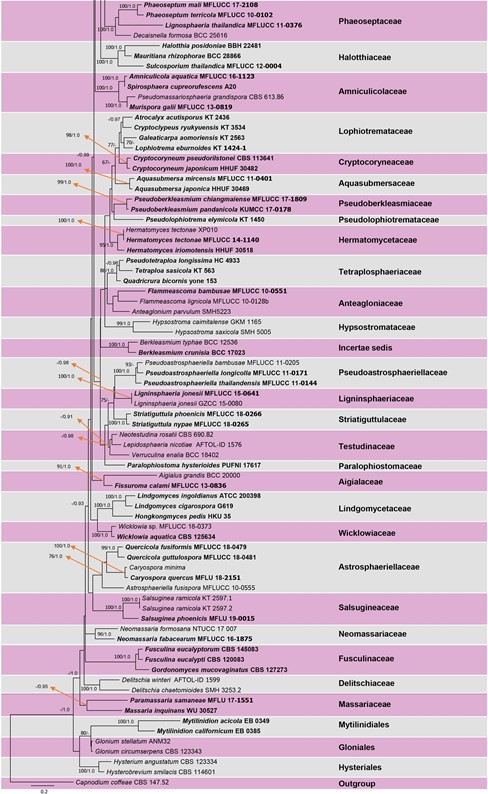Sublophiostoma Phookamsak, Hongsanan & K.D. Hyde, gen. nov.
Index Fungorum number: IF557972; Facesoffungi number: FoF09402.
Etymology: The generic epithet “Sublophiostoma” refers to the resemblance of Lophiostoma.
Saprobic on grasses and bamboo (Poaceae).
Sexual morph: Ascomata solitary to gregarious, scattered, immersed to semi-immersed or erumpent, visible as dark ellipsoidal spots on the host surface, uni-loculate, coria- ceous, black, subglobose, hemisphaerical to lenticular, glabrous, centrally ostiolate with minute papilla beneath the host tissue, with crest-like opening. Peridium thick at upper lateral part and thin at the base, composed of several layers of cells, with outer layers of thick, dark brown layers of cells of textura angularis and inner layers comprising hyaline, somewhat flattened cells of textura angularis to textura epidemoidea. Hamathecium compris- ing dense, septate, branched trabeculate pseudoparaphyses, embedded in a gelatinous matrix. Asci 8-spored, bitunicate, fissitunicate, cylindric-clavate, rounded at the apex, with a small bulbous pedicel, with well-developed ocular chamber. Ascospores uni to bi-seriate, partially overlapping, hyaline, fusiform, 1-septate, constricted at the septum, with each cell swollen near the septum, becoming acute at the ends, guttulate, smooth-walled, surrounded by a large mucilaginous sheath.
Asexual morph: Coelomycetous, produced on bamboo pieces on WA after 8 weeks, appearing as black, punctiform, globose structures, covered by grey to dark grey vegetative mycelium. Conidiomata solitary or aggregated, pycnidial, obpyriform. Conidiomata walls comprising of outer, brown cells of textura globulosa to textura angularis and inner, hyaline cells of textura angularis. Conidiophores reduced to conidiogenous cells. Conidiogenous cells hyaline, phialidic, integrated. Conidia aseptate, smooth- walled, subglobose to oblong, with two large guttules.
Type species: Sublophiostoma thailandica Phookamsak, Hongsanan, Goonas. & K.D. Hyde.
Notes: – Morphologically, Sublophiostoma resembles the genera in Lophiostomataceae such as Lophiostoma, Pseudolophiostoma and Vaginatispora based on its ascomata and asci. However, Sublophiostoma differs from these genera in having peridium with textura angularis to textura epidermoidea, 1-septate ascospores surrounded by wide sheath, while Lophiostoma, Pseudolophiostoma and Vaginatispora have peridium with textura angularis cells, 1- to multi-septate ascospores, lacking a mucilaginous sheath or surrounded by a thin sheath which is drawn out at the ends23. Phylogenetic analyses (Fig. 1) demonstrate that Sublophiostoma does not cluster with Lophiostomataceae and forms a distinct clade which cannot be assigned to any known family in Pleosporales. Therefore, the new family, Sublophiostomataceae is established to accommodate this genus.

Figure 1. Resulting phylogram of maximum-likelihood analysis based on a combined ITS, LSU, RPB2, SSU and TEF sequence data. Maximum likelihood bootstrap support values (ML) equal or higher than 60% and Bayesian probability values (BYPP) equal to or above 0.90 are given at the nodes (ML/ BYPP). The tree is rooted to Capnodium coffeae (CBS 147.52). Newly introduced strains are indicated in yellow and ex-type strains in bold.

Figure 1. (continued)
Species
